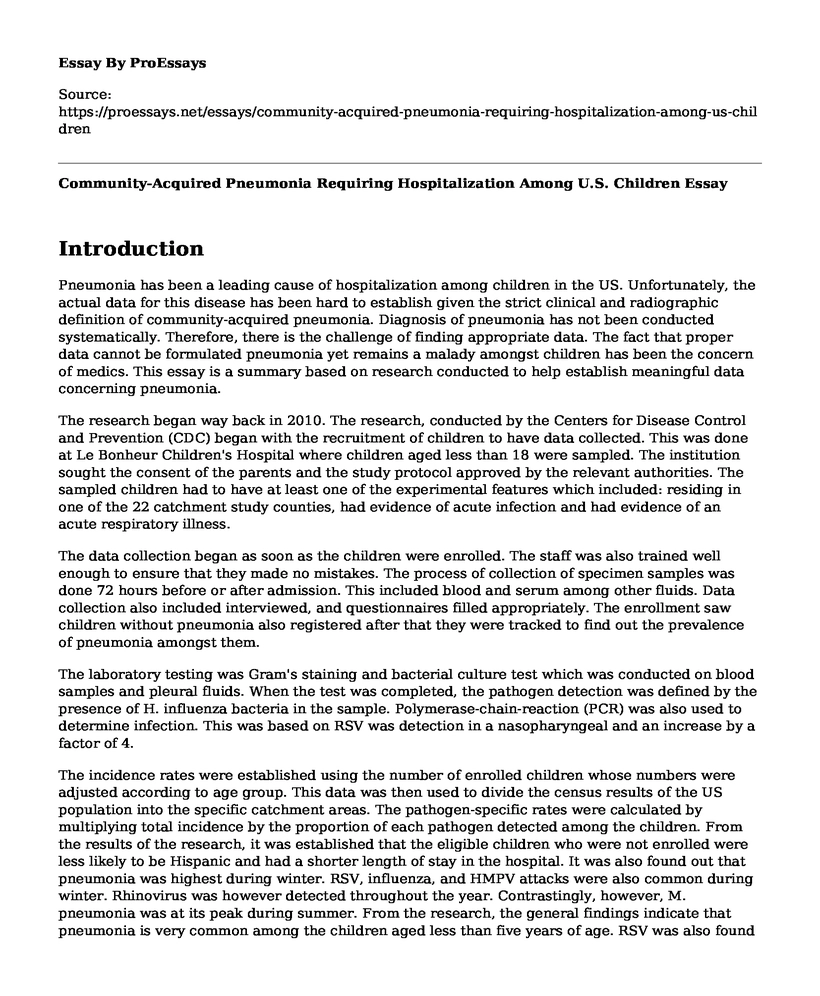Introduction
Pneumonia has been a leading cause of hospitalization among children in the US. Unfortunately, the actual data for this disease has been hard to establish given the strict clinical and radiographic definition of community-acquired pneumonia. Diagnosis of pneumonia has not been conducted systematically. Therefore, there is the challenge of finding appropriate data. The fact that proper data cannot be formulated pneumonia yet remains a malady amongst children has been the concern of medics. This essay is a summary based on research conducted to help establish meaningful data concerning pneumonia.
The research began way back in 2010. The research, conducted by the Centers for Disease Control and Prevention (CDC) began with the recruitment of children to have data collected. This was done at Le Bonheur Children's Hospital where children aged less than 18 were sampled. The institution sought the consent of the parents and the study protocol approved by the relevant authorities. The sampled children had to have at least one of the experimental features which included: residing in one of the 22 catchment study counties, had evidence of acute infection and had evidence of an acute respiratory illness.
The data collection began as soon as the children were enrolled. The staff was also trained well enough to ensure that they made no mistakes. The process of collection of specimen samples was done 72 hours before or after admission. This included blood and serum among other fluids. Data collection also included interviewed, and questionnaires filled appropriately. The enrollment saw children without pneumonia also registered after that they were tracked to find out the prevalence of pneumonia amongst them.
The laboratory testing was Gram's staining and bacterial culture test which was conducted on blood samples and pleural fluids. When the test was completed, the pathogen detection was defined by the presence of H. influenza bacteria in the sample. Polymerase-chain-reaction (PCR) was also used to determine infection. This was based on RSV was detection in a nasopharyngeal and an increase by a factor of 4.
The incidence rates were established using the number of enrolled children whose numbers were adjusted according to age group. This data was then used to divide the census results of the US population into the specific catchment areas. The pathogen-specific rates were calculated by multiplying total incidence by the proportion of each pathogen detected among the children. From the results of the research, it was established that the eligible children who were not enrolled were less likely to be Hispanic and had a shorter length of stay in the hospital. It was also found out that pneumonia was highest during winter. RSV, influenza, and HMPV attacks were also common during winter. Rhinovirus was however detected throughout the year. Contrastingly, however, M. pneumonia was at its peak during summer. From the research, the general findings indicate that pneumonia is very common among the children aged less than five years of age. RSV was also found to be common among children aged less than two years of age. Human rhinovirus and pneumonia were also found to exist commonly with 27 % of children with pneumonia testing positive with Human rhinovirus. The limitations of the research were that not all eligible children were enrolled. Even for the eligible enrolled, not all data was available. The samples could also not be justifiably be used to represent the entire population.
Conclusion
In summary, the research helped in capturing special information about pneumonia attacks among children. The very vital finding from this research was that the children aged below 5 were susceptible to pneumonia attacks.
Reference
Community-Acquired Pneumonia Requiring Hospitalization among U.S. Children | NEJM. (2015, February 25). Retrieved from https://www.nejm.org/doi/full/10.1056/NEJMoa1405870
Cite this page
Community-Acquired Pneumonia Requiring Hospitalization Among U.S. Children. (2022, Jul 18). Retrieved from https://proessays.net/essays/community-acquired-pneumonia-requiring-hospitalization-among-us-children
If you are the original author of this essay and no longer wish to have it published on the ProEssays website, please click below to request its removal:
- Essay Sample on the Legalization of Marijuana
- Health Disparities in Mississippi Essay
- Is Barefoot Running Easier on Your Joints? - Essay Sample
- Paper Example on Treating Hypertension & Heart Failure With Trandolapril
- Essay Example on Childhood Obesity in Alabama: A Community Health Assessment
- HIPAA: Protecting Patient Privacy in Healthcare Settings - Essay Sample
- Paper Example on COVID-19: Impact on Global Immigration and Economy







